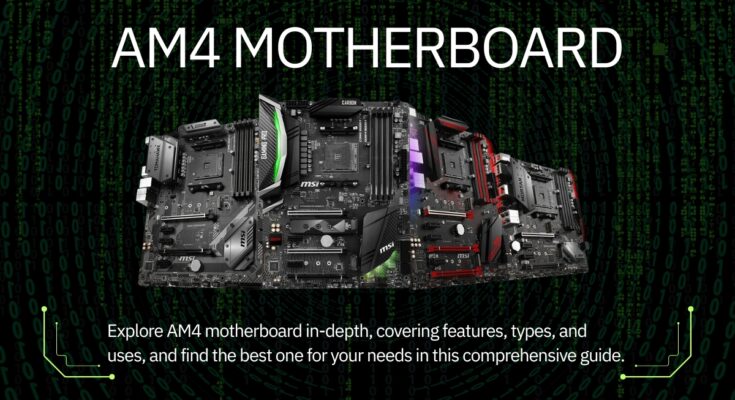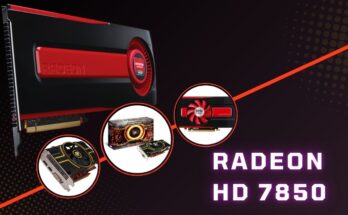Assembling a computer, this component fixes the major components of the system’s performance, compatibility, and usability—known as the motherboard. For AMD Ryzen lovers, the AM4 motherboard has been one of the best-performing boards that has received accolades for flexibility and performance upgrades. This article will explore these AM4 motherboards setting out their key functionalities up to understanding their utility giving tips on the right one for your next computer assembly.
What is an AM4 Motherboard?
Before the Ryzen processors were launched in 2016, it was a specialized type of motherboard to accommodate the AMD’s AM4 socket. This socket remained the standard across the Ryzen range, from the initial Ryzen 1000 series up to the newer Ryzen 5000. These motherboards have also stayed the center of AMD’s success in the CPU market by offering long-term compatibility and upgrade solutions to builders.
Why Are AM4 Motherboards So Popular?
This is Popular due to:
- Long-Term Compatibility: The AM4 socket has been supported for several processor generations it is one of the oldest platforms still used today in the modern PC market. These compatible features work both ways, to enable users to upgrade their CPUs without necessarily changing the motherboard.
- Performance for Multiple Use Cases: For gamers, content creators, or business professionals, all of These come with components that can be adapted in line with different performance requirements for gaming PCs to workstations.
- Cost-Effectiveness: AM4 motherboards provide a wide variety of chipset choices, from low-end ones that are affordable to high-end boards with the extra bells and whistles, depending on what the user may be willing to spend and what he or she may want the board to be able to do.
Features of AM4 Motherboards
1. PCIe 4.0 Support
In particular, the increased use of PCIe 4.0 as an option in some chipsets such as B550 and X570 deserves special attention. PCIe 4.0 delivers twice the data rate of PCIe 3.0, providing increased interfaces to GPUs as well as storage devices that rely on NVMe SSDs.
2. DDR4 Memory Support
It supports RAM, specifically DDR4 RAM, which is not only the latest in RAM for PCs in the market today. There are many benefits of this generation of DDR memory: DDR4 enables a higher data transfer rate than previous generations of DDR memory, it is more energy efficient than previous DDR memory and is more reliable than previous versions of DDR memory.
All of these motherboards contain max: All of them support up to 128 GB DDR4 RAM even though one may employ them for other types of RAM optimization for other practical purposes such as video improvement, and three-dimensional image creation.
3. USB 3.2 and Type-C Connectivity
You’re more likely to find motherboards with USB 3.2 and Type C ports capabilities fast data transfer rates as well as compatibility with the latest devices. These ports, they are suitable for people who have to send large files over the network Or use external devices that need fast connectivity.
4. M.2 NVMe Slots
Thanks to the expanded support of M.2 NVMe, it provides the opportunity to implement fast storage. Due to their inherent architecture, NVMe drives deliver noticeably faster and more impressive boot time, game as well as application load time, and system interactivity in contrast to SATA SSDs.
5. Advanced Power Delivery and Overclocking Support
Mainstream or mid to higher-end AM4 motherboards are those specifically in the X570 and the B550 specifically, that support enhanced PSUs. These power delivery systems enable the CPU to get a constant power supply necessary when one is overclocking or working under full load.
What Are These Motherboards Used For?
Gaming PCs
The primary role of the “AM4 motherboards” is in gaming systems and this certainly makes sense. These both support high-performance Ryzen processors, PCIe 4.0 for the latest Graphics card, and fast DDR4 memory which makes These perfect for building power gaming Computers. Component versatility in a series is possible with varied chipsets where gamers can pick a motherboard that meets their budget or performance level.
Benefits for Gamers:
- High FPS in Games: Combining an AM4 with a Ryzen CPU and an ultra-graphics card allows for optimal performance levels in the most realistic and newest video games, AAA.
- Future-Proofing: Integrated support for PCIe 4.0 and the latest and earlier generations of Ryzen processors, enables gamers to upgrade only the parts without needing to change the entire system.
Content Creation and Professional Workstations
AM4s are not just for gamers; many content creators, designers, and professionals who need complex performance for work involving video editing, 3D modeling, and rendering choose AM4s as their primary platform.
Benefits for Professionals:
- Multi-Core Performance: The ultimate performance of Ryzen processors across the multi-cores makes these motherboards perfect for applications that benefit from multi-core structures of software such as Adobe Premiere, Blender, and Civil Engineering CAD.
- High RAM Capacity: This makes it possible for professionals to run memory-intensive applications without any concern on the issue of bottlenecks about RAM since the memory module can support up to 128 GB of DDR4 RAM.
Budget Builds
It is an ideal option for those willing to work with a limited budget to create a cheap Pc especially those with chipsets such as the A320 and B450. These board features offer all the necessary capabilities to perform basic operations and some casual gaming and are recommended for student, work/home use, or home theater PCs (HTPCs).
Benefits for Budget Builders:
- Affordable Options: The A320 and B450 are very affordable solutions to get into the AM4 platform which supports Ryzen chips for good performance at a low price.
- Upgradeable Path: EBut even for the budget motherboards such as B450 there will always be a possibility for future upgrades and changing a potent CPU and GPU without changing the mainframe.
Types of AM4 Motherboards
A320 Motherboards
In particular, the A320 motherboards can be used to assemble basic systems. It offers all the primary features necessary to be of use which are necessary for the users who do not need extreme features or OC assistance. These motherboards are cheaper than Intel’s and the board that is in this category is perfect for economy-shoppers who want to construct a user-computer for routine usage.
B450 Motherboards
Designed for mid-range builds and provides optimum value for money. All of them allow for CPU overclocking, in other words, users may adjust the performance levels of Central Processing Units according to their preference.
Also, they provide better electricity output than A320 motherboards, which makes them good for users who seek elevated stability and performance increase without necessarily installing costly motherboards.
X470 Motherboards
X470 is special for high-performance applications, which have improved features of overclocking and better performance. The following are some of the enhancements that have been incorporated into these motherboards; Multiple Graphics Processing Unit support; and an enhanced cooling system. They are ideal for gamers and business people who want to work with their computers at their best.
B550 Motherboards
The B550 motherboards act as a mid-range to high-end board series in between the mid-tier option and high-end option. They include support for PCIe 4.0 for storage along with the GPU which provides a much higher data transfer rate than the old PCIe 3.0. Being mid-range boards with excellent characteristics B550 motherboards are perfect for gamers and content makers who need a solid and not extremely costly platform.
X570 Motherboards
Finally, the X570 chipset is aimed at the enthusiast and power user domain. It has the best set of features for creating high-performance PCIe 4.0 devices with great overclocking capabilities and superior power delivery. Many of these motherboards feature special add-ons like improved heat dissipation systems and compatibility with the latest high-speed memory and that is why they are perfect for users who wish to pull every ounce of performance out of their AM4-based system.
AM4 Motherboard Buyer’s Guide
Choosing the right AM4 board depends on several factors:
Purpose of the Build: There is a choice to be made about what kind of build you will be constructing – a gaming build, content creation build, or a general use build. An upper-level gaming build would require an X570 board while a small chassis build would only require only B450 or an A320 board.
Overclocking Requirements: If you’re going to overclock your CPU, cooling and the VRM becomes a big issue, X470 or X570 are the best choices.
Future-Proofing: To prepare for the future look for a B550 or X570 since these motherboards have support for PCIe 4.0, so you’ll be ready for generations of video cards and storage devices in the foreseeable future.
Connectivity Options: As in all the prior models, the top-level boards, specifically the X570 boards, offer additional features other than the basic connectivity that would include M.2, USB Type-C, and Wi-Fi 6 support.
Unique Features
1. AMD StoreMI Technology
Another component that is present in most of the board is the AMD StoreMI which is a storage product that has an SSD-level speed with an HDD tier size. This feature allows the users to link an SSD to improve the functionality of the system that contains often-used data on the SSD.
2. Precision Boost Overdrive abbreviated as PBO
It also enables the Precision Boost Overdrive (PBO) by AMD, a feature that automatically optimizes the CPU clocks based on the power, temperature, and loading for optimum results on intensive use without compensation.
3. Enhanced VRM Cooling
Features such as increased VRM heat sinks help maintain stable power supplies on high-end models such as the X570. This feature is necessary for efficient system stability and avoidance of system overheating essential for gaming and professional use.
Common Problems of AM4 Motherboards and How to Handle Them
1. BIOS Compatibility Issues
There are conflicts that you trigger between the old motherboard and the new Ryzen CPU, mostly identified by the BIOS compatibility problems. To correct this problem, go to the motherboard vendor’s website to download the BIOS that supports the new processor.
2. RAM Compatibility Problems
Certain users may face compatibility problems with RAM, especially with high-speed RAM. The RAM installed must be on the motherboard QVL (Qualified Vendor List) for improved compatibility and maximum performance.
3. Overheating Concerns
In a situation where your system is overheating, you might find that this could be attributed to a shortage of cooling options on the motherboard. If you can upgrade the VRM region of your motherboard or add more case fans to the mix then it is recommended that you do so.
Conclusion
The AM4 motherboards have made a profound positive impact on the PC building market through their aspects of flexibility, compatibility, and performance. For the gamers who want to build a strong machine, streamers and YouTubers who need a proper workstation, or the basic builders who just want a simple and good-performing build, there’s an AM4 for all.
AMD ends up supporting multiple generations of the Ryzen processors which helps users avoid the need to change the motherboard while upgrading their systems. The views about the following features will help in making an informed decision when deciding on the next build that will fit your goals and preferences perfectly.
FAQs
Is it possible to use a Ryzen 5000 series CPU with older AM4 motherboards – yes you can but how?
Of course, virtually all of the previous boards that came with B450 and X470 chips are compatible with Ryzen 5000 series CPUs if the BIOS has been patched.
What makes the B550 different from the X570?
The former large-scale is that X570 has more PCIe 4.0 IO and better overclocking performance While the Lian Li B550 is cheaper and has PCIe 4.0 for storage and graphics but that is all.
Are AM4 motherboards future-proof?
AM4 motherboards have been very much future-proof for several years now, and recently, AMD declared that, in the future, the AM5 socket is going to unseat AM4.
Are all these motherboards compatible with PCIe 4.0?
No, not all the AM4 motherboards support PCIe 4.0, and the ones that do are the B550 and X570 chipsets.
What should I look for in an AM4 motherboard designed especially for gaming?
For gaming, the components to consider include PCIe 4.0, good VRM cooling for overclocking, and multiple M.2 slots for faster storage.



